Based on insurance loss data, water damage accounts for well over a third of construction industry claims, reaching over $16 billion annually. That’s just the financial damage. Project delays, reputational impact, increased liability risk, and growing insurance premiums are further risks. That makes it essential for any construction project to consider all options to control water intrusion, including water sealing and waterproofing.
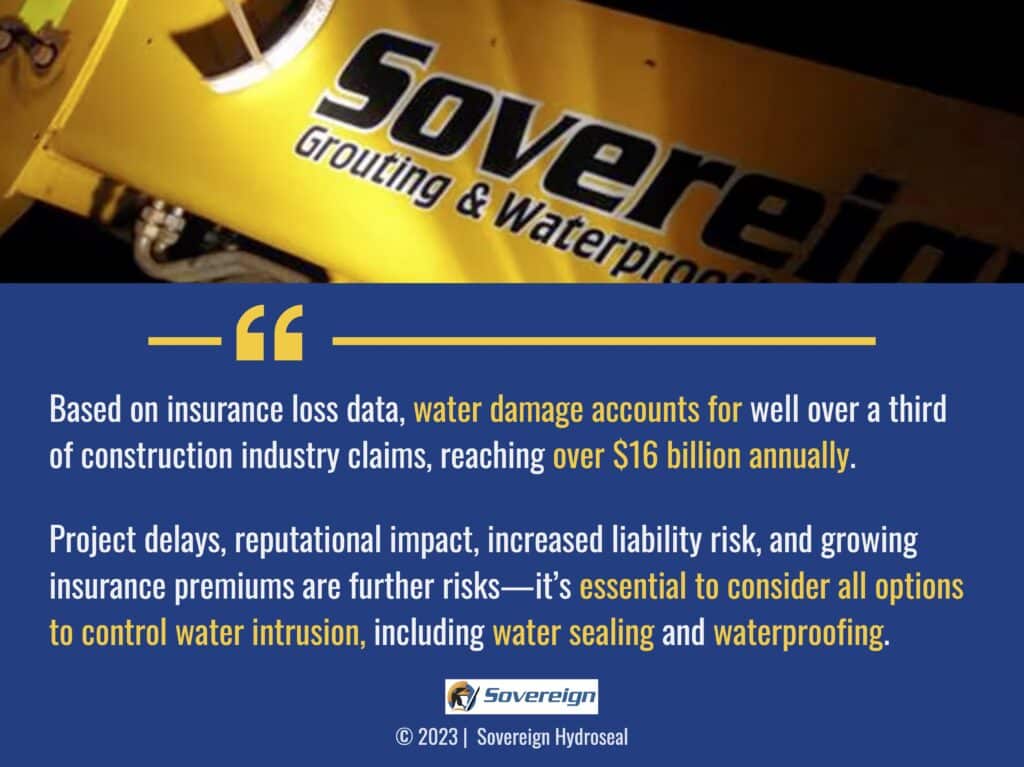
This article examines water damage sources, construction site planning, proactive erosion control, drainage systems, water sealing, and waterproofing approaches, including polymer-based emulsion grouting and it’s uses such as in soil improvement.
Exterior Construction Water Damage Sources
During excavation and foundation-building activities, unexpected groundwater issues and rainfall can have a considerable impact. Therefore, it’s critical to review all potential water damage issues at the construction site before moving a single shovel full of dirt.
Groundwater
A hydrologist can evaluate the local water table and determine ways to direct water flow away from the construction using perimeter drains and other water sealing options.
Surface water
This includes water running off the nearby properties from rain and melting snow, leaking irrigation systems, roof drains, and plumbing problems. It is also essential to examine the general contour of the land to note any required water mitigation for flood waters.
Rainfall
Identify rainfall volume and frequency, as it can impact construction activities and cause damage after the project has been completed.
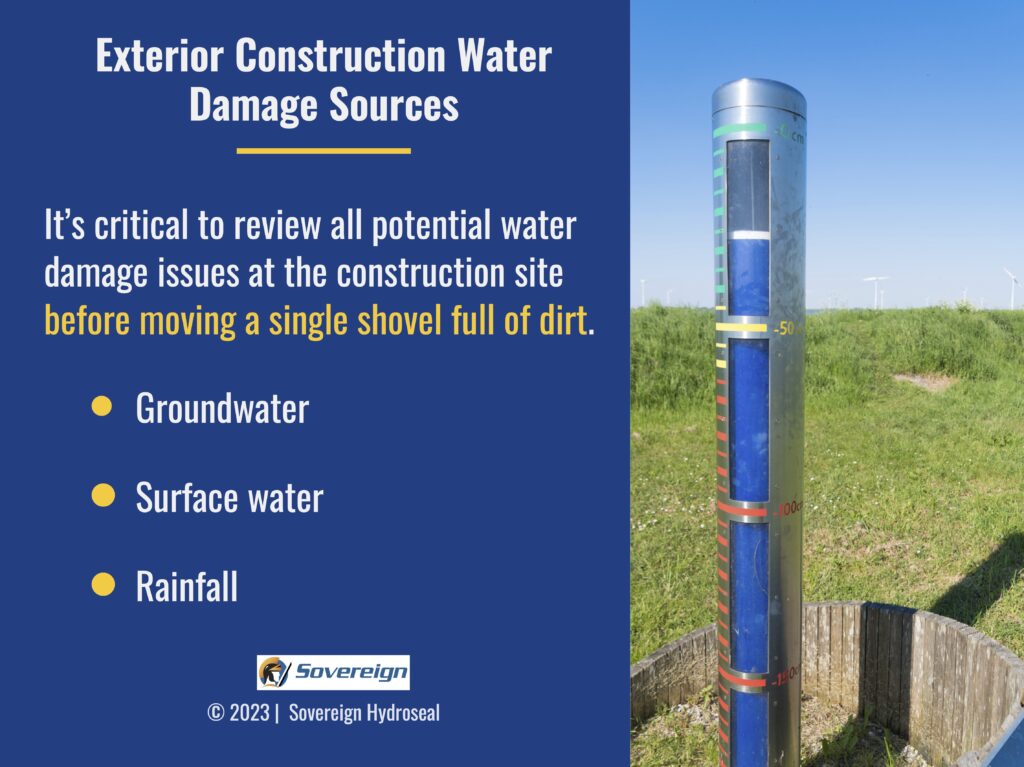
Construction Site Planning | Prevent Water Damage
Construction site development plans must consider all the exterior water sources listed above. That also means ensuring the grading plans divert water from the construction area, as well as implementing proper water-sealing and soil-improvement techniques for any retaining construction walls. Plus, connections to the sewer and stormwater systems should be made before the building construction starts to avoid disrupting the preconstruction soil improvement and grading.
Lastly, particular attention needs to be given to the building foundation. Water buildup around or underneath the foundation can be a disaster during construction and far worse once the building is completed.
Proactive Erosion Control of the Construction Site | Soil Improvement
Several essential soil conservation practices need to be used during the construction process. These include sediment basins, traps, and ponds that capture sediment-laden water. Steps should also be taken to minimize soil disturbance, which can lead to further loosening of the soil, causing water and wind erosion. Of course, covering exposed soil with mulch or a protective barrier can also reduce erosion.
Efficient and Effective Drainage Systems for Construction Sites
The earlier examination of the groundwater level, surface water runoff, and expected rainfall levels is the driver for implementing efficient and effective drainage. That can include French drains, surface drainage systems, water barriers, diverters, and stormwater systems. These systems must also be regularly inspected to ensure they don’t become clogged or overwhelmed by excessive water levels.
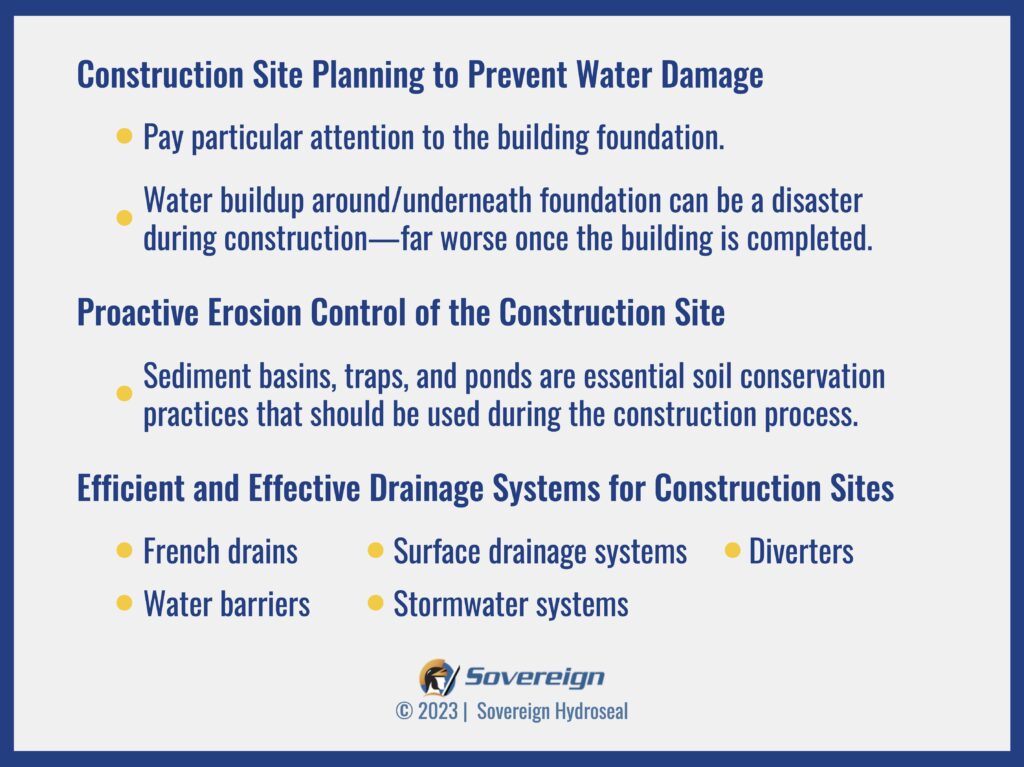
Water Sealing and Waterproofing
In an earlier blog post, we touched on jet grouting’s soil improvement applications – Jet Grouting for Soil Improvement | USA Excavation Support]. Among many applications, it can be used to create impermeable barriers to control groundwater flow and prevent seepage. It can also be used to build retaining walls using soil-cement columns. Jet grouting can further be used for slope stabilization to prevent erosion. It can be an effective option in your construction site water intrusion control toolkit.
Another highly effective tool is water sealing and waterproofing using grouts. Grouting is the injection of fluids into concrete, rock, or soil to fill the voids that allow water flow. There are three general categories of grouts.
- Particulate. These grouts contain solids mixed with water. The water transports the solids into the concrete, rock, or soil matrix. The particles then drop out to fill the voids. The challenge is that the particles must be small enough to penetrate the voids but large enough to seal the voids. They can slow the flow of water but cannot prevent it.
- Emulsion. These grouts also use solids suspended in a water carrier. But once forced into the voids, they form a jelly-like mass or gel. At that point, they can then cure into a flexible rubber-like plug that adheres to the structure. They are very effective at water sealing and waterproofing.
- Chemical. This type of grout contains solids or liquids that dissolve in water. The solution is then injected into the voids, where it reacts to form a continuous hydrogel.
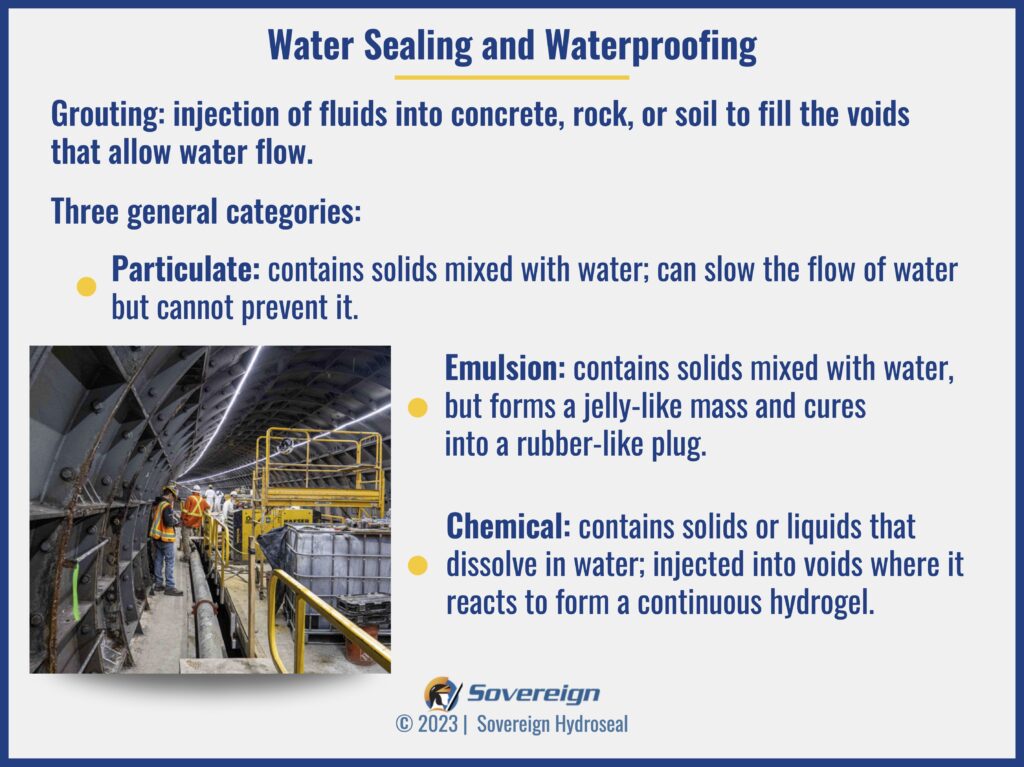
A Polymer-Based Emulsion Grout Company | Water Sealing and Waterproofing in the USA
We have developed an emulsion grout that works exceptionally well in mines and underground infrastructure for water sealing and waterproofing. It’s a polymer-based emulsion (PBE) grout. It offers a small particle size, low viscosity and miscibility in water, and can penetrate and seal water in small aperture fractures.
PBE offers three main advantages
- It can be diluted up to 15% of its original strength in water and still set effectively.
- It can be used as a one-part grout, eliminating predicting set time or predetermining a mixture.
- It sets when agitated, making it useful in turbulent, high-velocity water flow situations.
Chemical grouts require a chemical reaction between an agent and reagent to set. In contrast, a polymer-based emulsion grout can be set mechanically. No chemical reaction is necessary.
There are Four Ways to Either Induce or Influence PBE Setting
- Mechanical Activation. The flow of PBE through fissures develops a high-shear action that causes the polymer colloids to flocculate. They, in turn, adhere to the side walls, forming a jelly-like mass that builds up to block the fissures.
- Chemical Acceleration. A chemical activator can accelerate the PBE set if desired. It breaks the emulsion and induces the polymer colloids to coagulate in as quick as two seconds.
- Chemical Retardation. If the mechanical setting happens too quickly due to high pressure, small aperture fissures, or saline water, an inhibitor chemical can be used to allow greater grout spread away from the injection point.
- Atmosphere Exposure. PBE grout can also form a thin skin of very fine interlocking polymer laths when exposed to the atmosphere long enough to dehydrate.
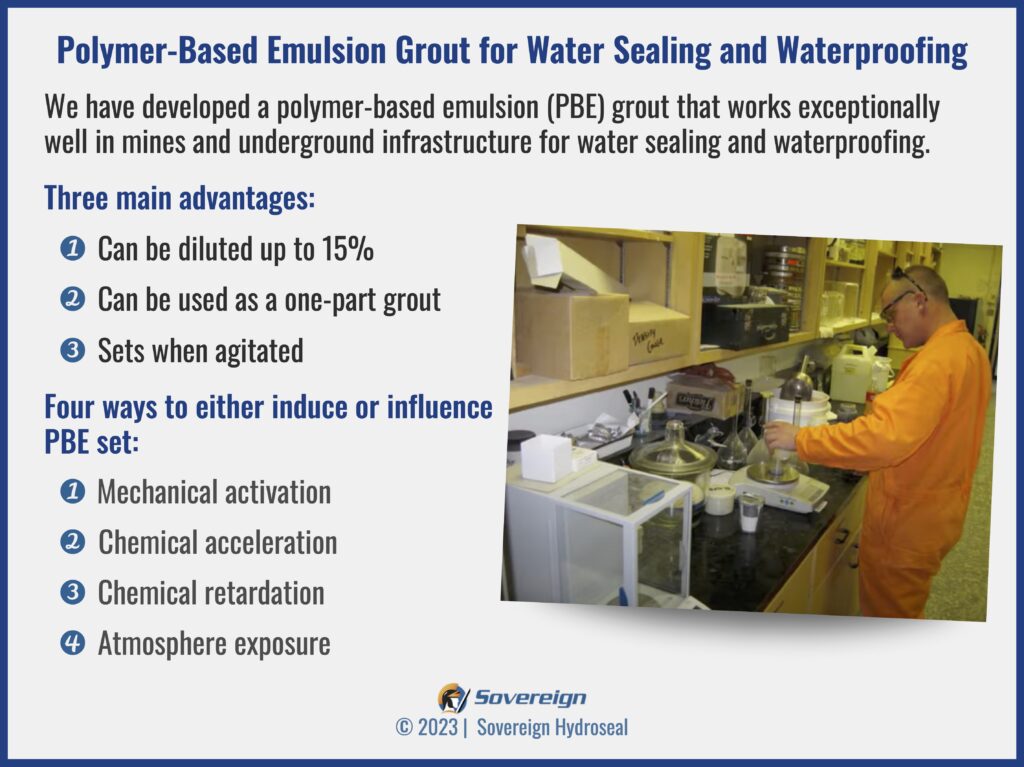
The curing of PBE happens over two stages. It forms a jelly-like mass and then converts to a flexible rubber-like plug or membrane. It is highly adhesive and bonds to concrete or rock. Even in the first stage of curing, PBE is resistant to washout.
When fully cured, PBE is not only strongly bonded to the rock or concrete, but it is highly durable, flexible, and impermeable. Tests have shown elongation greater than 350%. It has also maintained its water-sealing properties for over four decades and counting.
From this, you can readily see that PBE grout is highly effective in controlling water intrusion and quite versatile in meeting the needs of any application.
The Best Leak Remediation Company in the USA | We Can Meet Your Water Control, Water Sealing, and Waterproofing Needs
We’re not just one among many grout companies. We’re the leading leak remediation company in the USA that has proven its capabilities over the years across a wide range of projects. We got our start in mining leak remediation – one of the most challenging water control tasks due to the inaccessibility of leaks and the high-pressure water causing the leaks. With our expertise in mining leak remediation and civil projects, we bring our 50+ years of expertise and experience, along with our NOH2O® PBE grout, to resolve your water control challenges.
For further information or to explore project-specific information, please use our contact form, email us at info@sovereignhydroseal.com, or call us at +1 646.649.5878, and we can get started.

